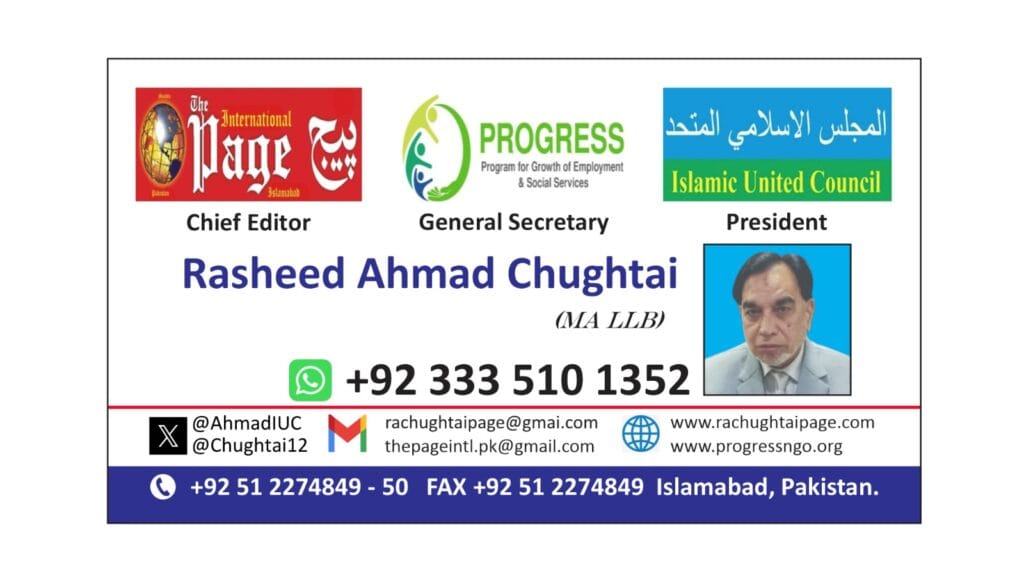Intelligence and Strategic Threat Assessment Report – Taliban’s Capacity to Curb the TTP Threat
From Tacit Tolerance to Tactical Control? Assessing the Afghan Taliban’s Capacity to Curb the TTP Threat – Implications for Pakistan, CPEC, and Regional Security

Rasheed Ahmad Chughtai
www.rachughtai.com
Executive Summary
Recent overtures by senior Afghan Taliban officials, including a rare public condemnation of Tehrik-i-Taliban Pakistan (TTP) attacks by Commander Saeedullah Saeed (May 2025), suggest a possible tactical shift in Kabul’s approach toward cross-border militancy. However, intelligence assessments indicate that the TTP remains operationally active**, with a recorded 65% increase in attacks in Pakistan’s Khyber Pakhtunkhwa (KP) and Balochistan provinces since 2023.
This report evaluates:
– The Afghan Taliban’s strategic calculus regarding the TTP.
– Pakistan’s counterterrorism response and its effectiveness.
– Geopolitical ramifications, including India’s potential exploitation of instability and China’s security concerns over CPEC.
– Projected scenarios based on current trajectories.
Key Findings:
– The Afghan Taliban faces internal factionalism—hardliners resist cracking down on TTP, while pragmatists seek international legitimacy.
– Pakistan’s kinetic operations (2024–2025) have degraded TTP’s infrastructure but failed to dismantle cross-border sanctuaries.
– China’s growing mediation role (evidenced by the May 2025 China-Pakistan-Afghanistan trilateral dialogue) signals heightened concerns over CPEC security.
– India may escalate covert support to TTP and Baloch separatists, leveraging Afghanistan as a staging ground for asymmetric warfare.
Current Threat Landscape
1. TTP’s Resurgence and Operational Capabilities (2023–2025)
– Reorganization under New Leadership: Following the death of Noor Wali Mehsud (2024), the TTP has adopted a decentralized command structure, making counterterrorism efforts more complex.
– Alliances with Baloch Separatists: Confirmed intelligence indicates TTP-BRA (Baloch Raji Aajoi Sangar) collaboration in attacks targeting CPEC infrastructure in Gwadar and Turbat.
– Foreign Backing Suspicions: RAW’s alleged financing of TTP splinter groups (Jaish-e-Pakistan, TTP-SWAT faction) remains under investigation.
2. Afghan Taliban’s Dual Policy: Rhetoric vs. Reality
– Public Statements vs. Action: Despite Saeed’s warning, TTP training camps remain active in Kunar, Nangarhar, and Paktika provinces (Satellite Intel, April 2025).
– Divisions Within the Taliban:
– Haqqani Network elements continue providing logistical support to TTP.
– IEA (Islamic Emirate of Afghanistan) leadership seeks to balance relations with Pakistan while avoiding alienating jihadist allies.
3. Pakistan’s Counterterrorism Response (2024–2025)
– Operation Azm-e-Istehkam (2024–Ongoing):
– North Waziristan drone strikes eliminated 12 high-value TTP targets.
– Increased fencing and surveillance along the Durand Line reduced infiltration by 40%.
– Diplomatic Outreach:
– China-mediated talks with the Taliban (May 2025) yielded pledges of cooperation but no verifiable crackdown.
Strategic Implications
1. Impact on CPEC and Chinese Interests
– Direct Threats to CPEC:
– Gwadar Port remains a prime target—TTP-Baloch attacks disrupted construction in March 2025.
– Chinese nationals increasingly vulnerable—kidnapping attempts in Zhob (April 2025).
– China’s Strategic Dilemma:
– Economic stakes vs. security risks—CPEC delays could force Beijing to reassess investments.
– Potential for PLA-backed security deployments in high-risk zones.
2. India’s Exploitation of Instability
– Hybrid Warfare Tactics:
– RAW’s alleged funding of TTP factions via Afghan intermediaries.
– Disinformation campaigns amplifying anti-CPEC narratives in Balochistan.
– Diplomatic Gains:
– India positioning itself as a “stable alternative” to Pakistan in Central Asian trade corridors.
3. Escalation Risks for Pakistan
– Military Retaliation:
– Possible cross-border raids into Afghanistan if Taliban inaction persists.
– Domestic Political Fallout:
– Public backlash against the government if terrorism spikes ahead of 2025 elections.
Projected Scenarios (2025–2026)
Projected Scenarios (2025–2026)
| Scenario | Probability | Potential Impact |
| Taliban Cracks Down on TTP | Low (30%) | Reduced attacks in Pakistan, improved Pak-Afghan relations |
| Continued Taliban Inaction | High (60%) | Escalating Pakistan-Afghanistan tensions, possible military confrontation |
| TTP-Baloch Merger | Medium (50%) | Severe CPEC disruptions, Chinese withdrawal from high-risk projects |
| India Expands Covert Ops | High (70%) | Increased terrorism in urban centers (Karachi, Lahore) |
Recommendations for Pakistan
Immediate Actions
1. Precision Strikes in Eastern Afghanistan: Expand drone operations targeting TTP leadership in Kunar & Nangarhar.
2. Enhanced Cyber & HUMINT Operations: Disrupt TTP financing networks linked to hostile agencies.
3. Fast-Track CPEC Security: Deploy SSG-trained security battalions to protect Chinese assets.
Long-Term Strategy
– Leverage SCO & OIC: Isolate the Taliban diplomatically unless verifiable action is taken.
– Balochistan Development Surge: Counter separatist narratives via economic incentives.
– Counter-Indian Influence: Expose RAW-TTP links through international media & UN forums.
Conclusion
The Afghan Taliban’s recent rhetoric does not yet signify a strategic pivot against the TTP. Pakistan must prepare for sustained hybrid warfare, with CPEC stability hanging in the balance. Without decisive Taliban action, military escalation with Afghanistan and intensified Indian subversion remain likely. Islamabad’s response must be multi-domain—kinetic, diplomatic, and economic—to mitigate this existential threat.
Rasheed Ahmad Chughtai
www,rachughtai.com


